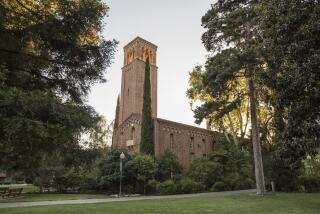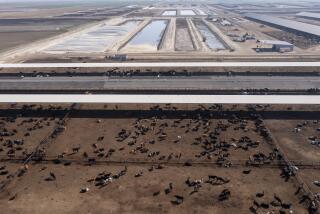Nation’s Rural School Systems Coping With Special Challenges : Education: Pupils have been scoring higher on national tests. Poverty, and not necessarily location, is a key factor in determining student performance.
- Share via
MILFORD, N.Y. — Applause echoes through the halls of Milford Central School. Follow the sound, and come to Erika Prouty’s third-grade classroom, where the youngsters have just tackled multiplication for the first time.
To some, applause for getting the answer to a math problem might seem a bit much. But to Prouty, it’s essential for building self-confidence and helping the children escape a life of rural poverty.
The U.S. Education Department estimates that 6.9 million students are enrolled in some 22,400 public schools in rural communities. With the exception of the Southeast, most rural school districts are small, with enrollments under 2,500.
Many of these schools are in impoverished regions. In 1990, the rural poverty rate was 16.3%, compared to 12.7% in metropolitan areas.
Teachers and school administrators often have to tend to children’s basic needs--food and clothing--before they can see to the academic ones.
Prouty’s voice breaks as she recalls the youngsters she has taught who came to school in the cold, upstate New York winters without socks, or with “patent leather shoes that didn’t buckle.”
But Madeleine Kunin, the Education Department’s deputy secretary, notes that all rural schools do not fit into a single mold.
“Simply being rural does not automatically determine that the school will be poorer in every sense,” she said.
But being rural does pose greater challenges for a school system.
Education costs in rural areas are high, in part because of the low population density. As a result, rural residents contribute greater percentages of their income to schools than people in urban or suburban areas, according to the department’s report, The Condition of Education in Rural Schools.
At the same time, younger adults are leaving rural areas in search of better jobs and higher wages, leaving a population that is, comparatively, older and less educated.
“One of the biggest problems in rural education is keeping youngsters in the community, trying to link them with opportunities for the future,” said Joseph Newlin, executive director of the National Rural Education Assn.
“With the departure of their youth, rural communities additionally fail to get a return on their educational investment,” the report said.
The department found that teachers and principals in rural schools generally were younger, less well-educated and earned less in pay and benefits than those in metropolitan or suburban districts.
Technology has helped fill some of the gap, providing long-distance professional development for teachers and a wide assortment of classes for students. “It helps rural schools answer the criticism sometimes that their curriculum is limited,” Newlin said.
Rural students have been scoring higher on national tests, and are now close to the national average, the Education Department report said. It found that poverty, and not necessarily location, was a key factor in determining student performance.
“It’s hard to see what exists in the homes of young people in your communities,” David Erdmann of the Foundation for Excellent Schools told a fall conference of rural school faculty and administrators in nearby Cooperstown. “Your schools are oases.”
Forty percent of the students at Milford Central School, which teaches 500 children in kindergarten through 12th grade, participate in the free or reduced price lunch program, where eligibility is based on family income.
Prouty and her colleagues want to make sure that students don’t let their poor standard of living get in the way of academic success.
With the help of the Vermont-based Foundation for Excellent Schools, they have formulated a plan to raise student aspirations, to open students’ minds and convince them they can overcome whatever barriers there are to their success.
Children as young as fourth-graders are taken on trips to local colleges to expose them to educational opportunities after high school; parents are invited to attend as well.
“Gold cards” offering discounts from local merchants will be given to students who do well in upper-level courses. The goal is to increase enrollment in those classes.
At nearby Worcester Central School, Jim Kenyon, chairman of the social studies department, has created a Wall of Success to encourage his students to aim higher.
“You know when you reach them because their eyes light up,” he said.
Across the walls of his classroom, students can read correspondence from the famous and not-so-famous about how they set goals, overcame obstacles and became successful.
“Kids ask, ‘What does it take to be successful?’ ” he said. “It’s something magical when they’re told by (basketball coach) Bobby Knight, who they see on TV, or Tim Conway, or a famous movie star.”
At Milford, Prouty’s third-graders talked about their ambitions as they wrote in diaries and finished creating their own island adventures.
Nicole Lawton wants to be an art teacher and teach right here at Milford Central School.
Scott Hefner dreams of attending Notre Dame University and playing football on the varsity.
But first there’s math to attend to.
“What is multiplication?” Prouty asks.
“Adding some numbers a whole bunch of times,” one child responds.
The class proceeds to do just that, using small, colored plastic pieces to help them.
The children encourage one another.
“All children like to show off,” Prouty said. “Once the parents see their kids getting enthusiastic, they start to get enthusiastic.”
If parents don’t come to school, Prouty goes to them, to discuss students’ progress.
Newlin said research has shown rural schools benefit from a strong family involvement in the education of children. “The parents can have almost a day-to-day acquaintance with the teachers and the school system,” he said.
In turn, the rural school often is the center of the community, hosting social as well as educational events.
“We are, still, in rural areas maybe more in tune with traditional American values, the heartland concept,” Newlin said.
More to Read
Sign up for Essential California
The most important California stories and recommendations in your inbox every morning.
You may occasionally receive promotional content from the Los Angeles Times.













